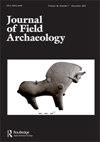Equality in the Periphery of Lamanai: Assessing a Maya Community in the 10th and 11th Centuries a.d.
IF 1.5
1区 历史学
0 ARCHAEOLOGY
引用次数: 0
Abstract
ABSTRACT This paper explores the spatial distribution of the built environment in the 10th and 11th centuries a.d. in the periphery of Lamanai, a Precolumbian Maya site in northern Belize. Analysis of structures, labor investments, and ceramic distributions indicates that the periphery was characterized by a small, monumental core between Lamanai and Ka’kabish, known as Coco Chan, which radiated outwards, with smaller structures in the periphery. Ceramic assemblages and their distributions show that artifacts are concentrated near Coco Chan, which may indicate differences in access to materials in the periphery of Lamanai. The Gini Index, a method used to measure dispersion, shows that the settlement (i.e., area per structure) has a relatively high degree of economic equality as compared to other areas in the Maya world. The structures and ceramic assemblages in the periphery of Lamanai may help to explain its uninterrupted occupation history.拉马奈周边的平等:评估公元10世纪和11世纪的玛雅社区。
摘要:本文探讨了伯利兹北部前哥伦布时期玛雅遗址拉玛奈周边公元10世纪和11世纪建筑环境的空间分布。对结构、劳动力投资和陶瓷分布的分析表明,外围的特点是在Lamanai和Ka’kabish之间有一个小而巨大的核心,称为Coco Chan,向外辐射,外围有较小的结构。陶瓷组合及其分布表明,古器物集中在Coco Chan附近,这可能表明拉玛奈周边地区获取材料的途径存在差异。基尼指数(一种用来衡量分散程度的方法)表明,与玛雅世界的其他地区相比,该定居点(即每个结构的面积)具有相对较高的经济平等程度。拉玛奈周边的结构和陶瓷组合可能有助于解释其不间断的占领历史。
本文章由计算机程序翻译,如有差异,请以英文原文为准。
求助全文
约1分钟内获得全文
求助全文
来源期刊

JOURNAL OF FIELD ARCHAEOLOGY
ARCHAEOLOGY-
CiteScore
4.60
自引率
5.30%
发文量
29
期刊介绍:
The Journal of Field Archaeology is an international, refereed journal serving the interests of archaeologists, anthropologists, historians, scientists, and others concerned with the recovery and interpretation of archaeological data. Its scope is worldwide and is not confined to any particular time period. Contributions in English are welcomed from all countries.
 求助内容:
求助内容: 应助结果提醒方式:
应助结果提醒方式:


